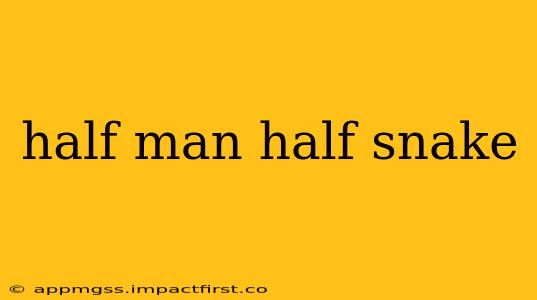The image of a being half man, half snake—a creature of both human and reptilian form—has captivated imaginations for millennia. This potent symbol appears across various cultures and mythologies, often imbued with complex symbolism representing both alluring beauty and terrifying danger. This exploration delves into the rich history and multifaceted interpretations of this intriguing figure, examining its presence in mythology, literature, and modern interpretations.
What is a Lamia?
The term "Lamia" most commonly refers to a creature from Greek mythology. These seductive female figures, often depicted with the lower body of a snake, were known for their insatiable hunger and predatory nature. They were believed to lure men and children to their deaths, sometimes even consuming their offspring. While depictions vary, the fundamental aspect remains: a hybrid creature bridging the human and serpentine worlds. Their stories highlight the perilous duality of beauty and destruction.
Are there other mythological beings that are half man, half snake?
Yes, the half-man, half-snake motif appears in various mythological traditions globally. While the Lamia is perhaps the most well-known example from Western mythology, similar creatures exist in other cultures. In some traditions, these beings are depicted as powerful deities or spirits, while in others, they are monstrous figures to be feared. The specific attributes and symbolism often differ based on cultural context. For instance, Nagas in Hindu and Buddhist mythology are often depicted as half-human, half-cobra deities associated with water, fertility, and protection. Their symbolism is far more positive than that of the Lamia.
What is the symbolism of a half man, half snake creature?
The symbolism of the half-man, half-snake creature is remarkably complex and multifaceted. The juxtaposition of human and snake forms creates a powerful visual representation of duality: the conflict between reason and instinct, civilization and wilderness, beauty and danger. The human aspect often represents intellect, social interaction, and morality, whereas the serpentine component symbolizes primal urges, deception, and the power of nature. This symbolic tension allows for diverse interpretations, varying across different contexts and narratives.
What are some examples of half man, half snake creatures in literature?
The half-man, half-snake figure has found a rich life in literature, inspiring writers to explore the themes of duality, temptation, and the blurring lines between humanity and nature. Authors have utilized this archetype to explore various psychological and moral dilemmas. Many modern interpretations move beyond the purely monstrous depiction, delving into the creature's potential for complexity and even empathy. This shift reflects changing cultural perspectives and a growing interest in nuanced representations of mythology.
How are half man, half snake creatures portrayed in modern media?
Modern media, encompassing film, video games, and novels, often reimagines these creatures, updating the mythology for contemporary audiences. While some portrayals maintain the traditional fearsome aspects, others explore alternative interpretations. Sometimes, the creature is given a more sympathetic portrayal, highlighting themes of alienation, otherness, and the struggle for identity in a world that doesn't fully understand or accept them. This reflects a modern interest in exploring marginalized identities and complex moral dilemmas.
Conclusion: The Enduring Power of the Half-Man, Half-Snake
The image of the half-man, half-snake figure continues to resonate with audiences today. Its enduring appeal stems from its ability to tap into primal fears and fascinations, while also offering a canvas for exploring complex human themes. The creature's symbolic richness allows for endless reinterpretations, making it a versatile figure in mythology, literature, and popular culture. Whether seen as a terrifying monster or a misunderstood being, the half-man, half-snake remains a powerful emblem of the duality inherent in the human condition and the enduring power of ancient myths.
